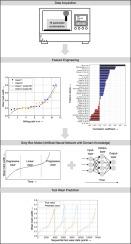基于灰盒模型的Ti-6Al-4V涂层切削齿铣削过程刀具磨损预测
IF 6.1
1区 工程技术
Q1 ENGINEERING, MECHANICAL
引用次数: 0
摘要
钛合金由于其高强度和耐腐蚀性以及低密度而广泛应用于航空航天,医疗和汽车工业。然而,钛的加工提出了重大的挑战,包括高机械负荷,产生过多的热量,并因此增加了刀具磨损。这种磨损导致表面质量差,尺寸不精确,并且由于意外停机和频繁更换工具而增加了生产成本。预测刀具磨损的传统监测方法,如定期检查和简单的阈值分析,通常效率低下且耗时。人工智能已经成为识别复杂磨损模式的强大工具,能够准确预测工具寿命和最佳更换时间。然而,人工智能模型经常被用作黑盒模型,因此缺乏可解释性。相比之下,仅基于物理原理的白盒模型往往无法捕捉复杂的磨损动态。灰盒模型结合了这两种方法,将领域知识与机器学习算法相结合,提高了预测的准确性和可靠性。本研究的一个特别优点是,数据集涵盖了完整的磨损曲线,包括渐进磨损阶段,而不仅仅是常用的0.3 mm的磨损极限。这使得模型可以在工具磨损的所有阶段进行训练和评估。本文提出了一种长短期记忆神经网络,该神经网络将刀具磨损物理行为的领域知识作为三次函数和损失函数,强制执行单调的刀具磨损行为。该模型在刀具磨损预测中的平均绝对误差为0.0447 mm,具有较好的性能。然而,由于整个数据曲线通常无法确定,因此无法与最先进的预测工具磨损的方法进行比较。本文章由计算机程序翻译,如有差异,请以英文原文为准。

Tool wear prediction for coated cutting inserts during milling of Ti-6Al-4V using a grey box model
Titanium alloys are widely used in aerospace, medical, and automotive industries due to their high strength and corrosion resistance, as well as low density. However, the machining of titanium presents significant challenges, including high mechanical loads, excessive heat generation, and, thus, increased tool wear. This wear leads to a poor surface quality, dimensional inaccuracies, and increased production costs due to an unplanned downtime and frequent tool replacements. Traditional monitoring methods for predicting tool wear, such as periodic inspections and simple threshold analyses, are often inefficient and time consuming. Artificial Intelligence has emerged as a powerful tool for identifying complex wear patterns, enabling accurate predictions of tool life and optimal replacement timing. However, Artificial Intelligence models are often used as black box models and therefore lack interpretability. In contrast, white box models, which are based only on physical principles, often fail to capture complex wear dynamics. Grey box models combine both approaches, integrating domain knowledge with machine learning algorithms to enhance prediction accuracy and reliability. A particular strength of the present study is that the dataset covers the complete wear curve, including the progressive wear phase, and not only up to the commonly used wear limit of 0.3 mm. This allows the model to be trained and evaluated across all stages of tool wear. In this article, a Long Short-Term Memory Neural Network with domain knowledge of the physical behaviour of tool wear as a cubic function and a loss function that enforces monotonic tool wear behaviour is presented. The performance of the model achieved a mean absolute error in the tool wear prediction of 0.0447 mm, which is good. However, it could not be compared to state-of-the-art approaches for predicting tool wear because the entire data curve is not usually determined.
求助全文
通过发布文献求助,成功后即可免费获取论文全文。
去求助
来源期刊

Wear
工程技术-材料科学:综合
CiteScore
8.80
自引率
8.00%
发文量
280
审稿时长
47 days
期刊介绍:
Wear journal is dedicated to the advancement of basic and applied knowledge concerning the nature of wear of materials. Broadly, topics of interest range from development of fundamental understanding of the mechanisms of wear to innovative solutions to practical engineering problems. Authors of experimental studies are expected to comment on the repeatability of the data, and whenever possible, conduct multiple measurements under similar testing conditions. Further, Wear embraces the highest standards of professional ethics, and the detection of matching content, either in written or graphical form, from other publications by the current authors or by others, may result in rejection.
 求助内容:
求助内容: 应助结果提醒方式:
应助结果提醒方式:


